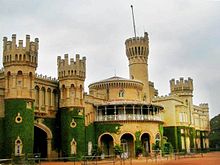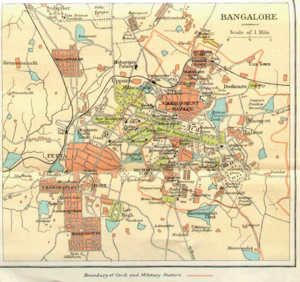History of Bangalore

Bangalore is the capital city of the
Medieval period
The oldest inscription in current-day Bengaluru is the Hebbal-Kittayya inscription, which dates back to the Ganga dynasty in Karnataka and mentions the administration of Sripurusha. Carved in early Kannada script, it pays tribute to Kittayya, who was martyred defending his land in a battle during Sripurusha’s reign.[2] The Gangas ruled Gangavadi from Kolar starting c. 350 and later shifted their capital to Talakadu.[3]
The first mention of the name Bengaluru, albeit in the form 'Benguluru' is from an inscription in Begur dated to 9th century AD. Written in Halegannada (ancient Kannada), it mentions 'Bengaluru Kadana' (battle of Bengaluru). The inscription stone found near Begur reveals, that the district was part of the Ganga Kingdom ruled from Gangavadi until 1024 AD and was known as 'Benga-val-oru', the City of Guards in old Kannada.[4]
Edgar Thurston (Castes and Tribes of India Volume 5) states that the

In 1024 AD, the
Vijayanagara and Kempe Gowda
Kempe Gowda I, Modern Bangalore was founded by a feudatory of the Vijayanagara Empire, who built a mud fort in the year 1537. Kempe Gowda also referred to the new town as his "gandu bhoomi" or "Land of Heroes".[5] Within Bangalore, the town was divided into petes (IPA: [pete]) or market. The town had two main streets: Chikkapete Street ran east–west and Doddapete Street ran north–south. Their intersection formed Doddapete square[6] – the heart of then Bangalore. Kempe Gowda's successor, Kempe Gowda II, built temples, tanks including Kempapura and Karanjikere tanks and four watching towers that marked Bangalore's boundary.[7] There is an inscription dated 1628 C.E in the Ranganatha Temple in Telugu. The English translation of which is "Be it well, When Rajadhi-Raja-Parameshwara Vira Pratapa Vira-Maha-Deva Maharaya seated in the Jewel throne was ruling the empire of the world: When of the Asannavakula, the Yelahanka Nadu Prabhu Kempanacharya-Gauni's grandson Kempe Gowda's son, Immadi Kempegaunayya was ruling a peaceful kingdom in righteousness with the decline of the Vijayanagar empire, the eclipse of the rule of Yelahanka Nadu Prabhus took place at the dawn of the 17th century."
The four watchtowers built at the time in Bangalore are still seen today in the following places which are :
- Lal Bagh Botanical Garden[8]
- Kempambudhi Tank
- Ulsoor Lake
- Mekhri Circle
Sultanate of Bijapur and Marathas
It was captured by the
Mughal Influence
After conquering the Sultanate of Bijapur, the
Hyder Ali and Tipu Sultan
When Hyder Ali died in 1782,
Wodeyars and British East India

Upon the passing of Tipu Sultan, the Wodeyars returned to the throne of
The 'Residency' of Mysore State was first established at Mysore in 1799 and later shifted to Bengaluru in the year 1804. It was abolished in the year 1843 only to be revived in 1881 at Bengaluru and finally to be closed down in 1947 with the departure of the British. (https://web.archive.org/web/20120206190404/http://rajbhavan.kar.nic.in/history/fromresi-rajbhavan.htm)
The British troops which were first stationed at Srirangapatna after the fall of Tipu Sultan in 1799 were later shifted to the Civil and Military Station of Bangalore in 1809.
The salubrious climate of Bangalore attracted the ruling class and led to the establishment of the famous Military Cantonment, a city-state close to the old town of Bangalore. The area became not only a military base for the British but also a settlement for a large number of Europeans, Anglo-Indians and missionaries.
In Cantonment, the names of many of its streets are derived from military
The Cantonment has retained it distinct atmosphere through the years with large populations of Anglo-Indians and Tamils from the British era.

Water shortages
The lack of water supplies within the city of Bangalore was first tackled in 1873 by building a chain of tanks called Miller's Tanks in the Cantonment area. Prior to this water was pumped from the Halsoor, Shoolay and Pudupacherry tanks which were insufficient for the Civil and Military Station. The city area drew water from a Karanjee system from Dharmambudhi and Sampangi tanks. The Great Famine of 1875-77
Plague-Crisis of 1898
Bangalore was hit by a plague epidemic in 1898.[16] The epidemic took a huge toll and many temples were built during this time, dedicated to the goddess Mariamma. The crisis caused by this epidemic catalyzed the improvement and sanitation of Bengaluru and, in turn, improvements in sanitation and health facilities helped to modernize Bengaluru.
Telephone lines were laid to help coordinate anti-plague operations. Regulations for building new houses with proper sanitation facilities came into effect. A health officer was appointed in 1898, the city was divided into four wards for better coordination and the
1900s

Sometimes it is claimed that, in 1906, Bangalore became the first city in Asia to have electricity, supplied by the
Basavanagudi (named either after the Basavanna Temple or the
Bangalore's reputation as the Garden City of India began in 1927 with the
Indian Independence (1947)
After Indian independence in August 1947, Bangalore remained in the Mysore State of which the Maharaja of Mysore was the Rajapramukharu.[17]

Bangalore continued to be the capital of the unified and linguistically homogeneous Kannada-speaking new Mysore state that was created in 1956, and renamed to Karnataka in 1973.
Kumara Park came into existence in 1947 and
Public sector employment and education provided opportunities for Kannadigas from the rest of the state to migrate to the city. In the decades that followed, Bangalore's manufacturing base continued to expand with the establishment of private companies such as
1991 Economic Reforms
Bangalore experienced a growth in its real estates e market in the 1980s and 1990s, spurred by capital investors from other parts of the country who converted Bangalore's large plots and colonial bungalows into multi-storied apartments. In 1985, Texas Instruments became the first multinational corporation to set up base in Bangalore. Other information technology companies followed suit, and, by the end of the 20th century, Bangalore had firmly established itself as the Silicon Valley of India.
With an estimated population of 8.5 million in 2011, [18] Bangalore is now the fourth most populous city in India and the 28th most populous city in the world. [19] Bangalore was the fastest-growing Indian metropolis after New Delhi between 1991–2001.
In 2005, the Government of Karnataka announced it had accepted a proposal to rename Bangalore to Bengaluru. [20] In 2006, the
| Year | Pop. | ±% |
|---|---|---|
| 1871 | 142,513 | — |
| 1881 | 155,857 | +9.4% |
| 1891 | 180,366 | +15.7% |
| 1901 | 159,030 | −11.8% |
| 1911 | 189,485 | +19.2% |
| 1921 | 237,496 | +25.3% |
| 1931 | 306,470 | +29.0% |
| 1941 | 406,760 | +32.7% |
| 1951 | 778,977 | +91.5% |
| 1961 | 1,199,931 | +54.0% |
| 1971 | 1,653,779 | +37.8% |
| 1981 | 2,913,537 | +76.2% |
| 1991 | 3,628,165 | +24.5% |
See also
- History of India
- Bengaluru
- Bengaluru Pete
- Mysore State
- Malleshwaram
Notes
- ^ "Inscription reveals Bengaluru is over 1,000 years old". The Hindu. 20 August 2004. Archived from the original on 12 September 2004. Retrieved 28 December 2012.
- ^ "Sister duo build fictional stories from inscription stones dating back to Karnataka's Ganga dynasty". The Economic Times. 30 April 2019. Retrieved 23 November 2021.
- ^ "History of Bangalore".
- Times of India. 2 December 2012. Retrieved 23 November 2021.
- ^ "About Bangalore - History". Department of IT and Biotechnology, Government of Karnataka. Archived from the original on 19 September 2006.
- ^ "The Making of Bengaluru". www.livehistoryindia.com. Retrieved 27 January 2021.
- ^ Vagale, Uday Kumar. "Public Space in Bengaluru: Present and Future Projections". Digital Libraries and Archives. 2006. Virginia Tech. 27 April 2004.
- ^ Vinoda, K. (27 September 1989). The Lalbagh - A History, By K. Vinoda. Department of history, Bangalore University. p. 1.
- ^ "The Marathas: Shivaji's Ancestors". www.historyfiles.co.uk. Retrieved 6 January 2021.
- ^ "How Bengaluru was bought for Rs 3 lakh 333 years ago | Deccan Herald -".
- ^ Hayavadana Rao C (1946). History Of Mysore 1399-1799 Vol Ii. p. 362.
- ^ William Edward Hartpole Lecky (1911). A History Of England In The Eighteenth Century. p. 87.
- ^ Sandes, Lt Col E.W.C. (1933). The Military Engineer in India, Vol I. Chatham: The Institution of Royal Engineers. pp. 163–165.
- ^ "A devastating famine". Deccan Herald. 4 August 2014. Retrieved 18 January 2021.
- ^ Hassan (1970):183-194
- PMID 32517609.
- ^ a b Srinivasaraju, Sugata (10 April 2006). "ElectriCity". Outlook India. Retrieved 15 November 2011.
- ^ "Urban Agglomerations/Cities having population 1 lakh and above" (PDF). Censusindia. The Registrar General & Census Commissioner, India. Retrieved 17 October 2011.
- ^ "World: largest cities and towns and statistics of their population". World-Gazetter.com. Archived from the original on 17 December 2012. Retrieved 17 October 2007.
- ^ "Bangalore to be renamed Bengaluru". The Times of India. India. 11 December 2005. Archived from the original on 29 September 2012. Retrieved 19 April 2009.
- ^ "It will be 'Bengaluru', resolves BMP". The Hindu. Chennai, India. 28 September 2006. Archived from the original on 1 October 2007. Retrieved 16 May 2007.
- ^ "Centre mum on 'Bengaluru'". The Hindu. Chennai, India. 18 December 2007. Archived from the original on 19 December 2007. Retrieved 10 April 2008.
- ^ Indian Express. "Bangalore is now Bengaluru". (149 KB).
References
- Fazlul Hasan. 1970. Bengaluru Through the Centuries. Historical Publications.
- Sundara Rao, B.N. 1985. Bengalurina Itihasa - A History of Bangalore in Kannada. Second reprint 2011, Ankita Pustaka, Bangalore.
- Annaswamy, T.V. 2003. Bengaluru to Bangalore: urban history of Bangalore from the pre-historic period to the end of the 18th century. Vengadam Publications, Bangalore.
